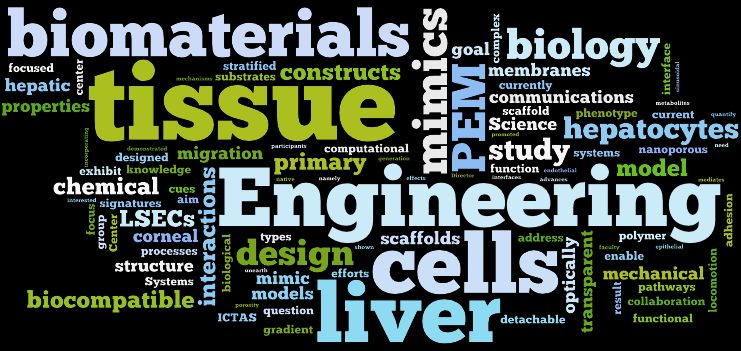
Laboratory for Biomaterials and Tissue Engineering
Research Overview
The Rajagopalan research group focuses on the development of 3D multi-cellular tissue organoids of the liver, GI, airway, and tumors (glioblastomas). We focus on designing tissue models that closely emulate the physical, mechanical, chemical, and biological environment found in vivo. By building such tissues, our group has investigated intercellular communications, inter-organ crosstalk, signaling pathways and cell-substate interactions. Research in our group lies at the interface of biomaterials, tissue engineering, biology and computational methods. An increasing focus of our research is to use computational and statistical models to predict tissue function, for example, to understand basic liver biology and to study the toxic effects of environmental chemicals on the liver.
Funding
We gratefully acknowledge funding for our research from USDA-NIFA, National Science Foundation (DMR, CMMI, CBET, DBI), National Institutes of Health (NIDDK), US Environmental Protection Agency (US-EPA), the Jeffress Memorial Trust, Virginia Tech's Institute for Critical Technology and Applied Science (ICTAS) and the Interdisciplinary Graduate Education Program on Computational Tissue Engineering (CTE-IGEP) at Virginia Tech.
3D Liver Organoids

The liver is a highly vascularized organ with a stratified cellular structure. Our group has successfully designed innovative multi-cellular in vitro liver models that recapitulate key aspects of hepatic cellular composition and architecture. Using these novel in vitro liver models, we have conducted detailed studies on hepatoxicity, fibrosis, and how the mechanical environment affects hepatic phenotypes. We have also performed transcriptomic and proteomic analyses to elucidate intra- and inter-cellular signaling. Our current focus is on designing liver organoids with primary human cells and IPSC-derived hepatocyte like cells.
Investigating Trans-differentiation in 3D Glioblastoma Organoids

Glioblastoma is a very aggressive form of brain cancer. Our goal is to investigate how human glioblastoma cancer stem cells migrate and interact with vasculature in 3D environments. We investigate the role of the biomaterial scaffold in promoting such interactions and how GBM cells trans-differentiate when localized near endothelial cells. Our studies aim to elucidate how the mechanical and chemical properties of the tumor environment contribute to these processes to ultimately aid in the design of therapeutics.
Investigating Bovine Respiratory Disease (BRD) in 3D Airway Lung Organoids
Bovine Respiratory Disease (BRD) is a multifactorial condition where different genera of bacteria, such as Mannheimia haemolytica, Histophilus somni, Pasteurella multocida, Mycoplasma bovis, and viruses such as Bovine Respiratory Syncytial Virus, Bovine Viral Diarrhea Virus, and Bovine Herpes Virus-1, infect the respiratory system of cattle. We are investigating how bacterial biofilms grow and adhere onto lung organoids and how to treat bacterial biofilms with a class of new drugs.
Investigating the effects of the SARS-CoV-2 virus on Coagulation and Hepatic Function

We have recently embarked upon two interdisciplinary collaborations on COVID-19. In the first, our group and our collaborators are using machine learning and network biology techniques to repurpose approved drugs for human diseases as treatments for COVID-19. The group has revealed drugs that may combat the abnormal blood coagulation seen in COVID-19 patients. In a second project, we are investigating the mechanisms by which the liver may cause abnormal blood coagulation.



